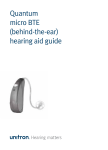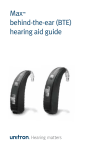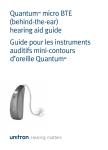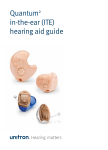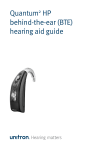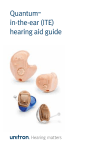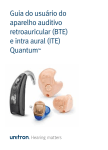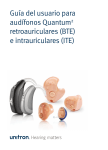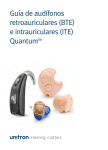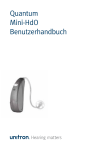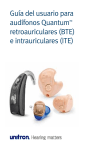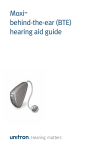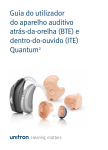Download Unitron Next ITE series Operating instructions
Transcript
Quantum behind-the-ear (BTE) and in-the-ear (ITE) hearing aid guide ™ Thank you Thank you for choosing Unitron hearing aids. At Unitron, we care deeply about people with hearing loss. We work closely with hearing healthcare professionals to make advanced, purpose-driven solutions available to everyone. Because hearing matters. Your BTE hearing aids Hearing healthcare professional:______________ ____________________________________ Telephone:_ __________________________________ Model:_______________________________________ Serial number:________________________________ Replacement batteries: Size 13 Warranty:_ ___________________________________ Program 1 is for: _______________________________ Program 2 is for: _ _____________________________ Program 3 is for: _ _____________________________ Program 4 is for: _ _____________________________ Date of purchase:______________________________ BTE quick reference Changing batteries Your ITE hearing aids Low battery warning 2 beeps every 30 minutes Plus (+) signs Hearing healthcare professional:______________ ____________________________________ Telephone:_ __________________________________ 13 Model:_______________________________________ On/Off Serial number:________________________________ Replacement batteries: Size 10 Size 312 on off open Lever volume control; up=louder, down=softer comfort-clarity control; up=clarity, down=comfort Push button switching programs volume control; right aid=louder, left aid=softer comfort-clarity control; right aid=clarity, left aid=comfort Size 13 Warranty:_ ___________________________________ Program 1 is for: _______________________________ Program 2 is for: _ _____________________________ Program 3 is for: _ _____________________________ Program 4 is for: _ _____________________________ Date of purchase:______________________________ ITE quick reference Table of contents Changing batteries Low battery warning Plus (+) signs 2 beeps every 30 minutes Plus (+) signs On/Off Battery size 10 312 on off open 13 Rotary dial or scroll wheel v olume control; up=louder, down=softer comfort-clarity control; up=clarity, down=comfort Push button switching programs volume control; right aid=louder, left aid=softer comfort-clarity control; right aid=clarity, left aid=comfort Contents Tips for wearing hearing aids for the first time........................................2 Your BTE hearing aids at a glance............................................................4 Putting your BTE hearing aids on your ears............................................6 Turning your BTE hearing aids on and off ...............................................8 BTE battery information......................................................................... 10 BTE operating instructions . .................................................................. 14 Cleaning your BTE hearing aids.............................................................22 Assistive listening devices for BTEs.......................................................26 BTE troubleshooting guide....................................................................28 Your ITE hearing aids at a glance...........................................................34 Putting your ITE hearing aids on your ears............................................36 Turning your ITE hearing aids on and off ..............................................38 ITE battery information..........................................................................39 ITE operating instructions......................................................................42 Cleaning your ITE hearing aids..............................................................50 Assistive listening devices for ITEs........................................................ 51 ITE troubleshooting guide.....................................................................52 Using the telephone..............................................................................56 Caring for your hearing aids...................................................................59 Signature features of your hearing aids................................................60 Warnings................................................................................................63 Compliance information........................................................................68 Client feedback......................................................................................70 Additional notes..................................................................................... 71 Tips for wearing hearing aids for the first time 1.Start in a quiet room at home first to get used to the new sound quality. Sounds like the ticking of a clock, the humming of the computer, the beep of the microwave or the rustling of clothes or paper may seem loud to you at first, because you have not been hearing them properly for a long time. 2.Read aloud to yourself and learn to correct the volume of your own voice when you are wearing the hearing aids. 3.Talk to different people and learn how to distinguish between different sound patterns again. 4.It will take some time before you are completely used to your hearing aids and can fully enjoy the benefits. 5.Wear your hearing aids for as many hours a day as you can, and for a little longer each day. 2 6. Make notes at the back of this booklet, write down difficult situations and describe what any unpleasant noises were like. This information will help your hearing healthcare professional to fine-tune the devices better for you. 7.Involve your family and friends in this familiarization period. For example, ask someone to set the television to a comfortable volume. 8.When you are beginning to get used to wearing the hearing aids, wear them in more difficult listening environments such as the office, at parties or in restaurants. This can be difficult even for people who can hear normally. Give yourself time to regain your ability to hear in these difficult situations. 9.Make your hearing aids part of your everyday life and be patient with yourself until you have retrained yourself to interpret the sounds correctly. 3 Your BTE hearing aids at a glance 1 E arhook - your custom made earmold attaches to your hearing aids using the earhook 2 Microphone - sound enters your hearing aids via the microphones. Microphone shield - protects microphones from dirt & debris 3 Push button - switches between listening programs or changes the volume level or comfortclarity, depending on your customized fitting 4 Lever - controls either the volume or comfortclarity, depending on your customized fitting 5 Battery door/on & off - close the door to turn on your hearing aids, partly open the door to turn off your hearing aids. Opening the door all the way gives you access to change the battery 6 Earmold - allows the sound to pass from the hearing aids to the ear and holds the hearing aids in place 7 Slim tube - sound travels down the slim tube to the ear canal 8 Dome - holds the slim tube in place in your ear canal 9 Retention piece - helps prevent the dome and slim tube from moving out of the ear canal 4 2 3 2 1 4 5 2 3 2 6 7 4 5 8 9 5 Putting your BTE hearing aids on your ears 3.Place the hearing aid over the top of your ear. 3. Your behind-the-ear (BTE) hearing aids may be color-coded with a small dot on the battery door: BTEs with slim tubes red = right ear; blue = left ear. BTEs with earmolds 1. 1.Hold the earmold between your thumb and index finger. The opening should be pointing in towards your ear canal with the BTE resting upwards over the top of your ear. 2.Carefully insert the earmold 2. in your ear. You may need to twist it slightly to the back. The earmold should fit into your ear snugly and comfortably. Pulling down and back on your earlobe may help you insert the earmold into your ear canal more easily. 6 1.Place the hearing aid over the top of your ear. The slim tube should lie flush against your head and not stick out. 1. 2.Hold the slim tube where it attaches to the dome and gently push the dome into your ear canal. 2. 3.Place the retention piece in your ear so it rests at the bottom of the opening of your ear canal. 3. 7 Turning your BTE hearing aids on and off Your hearing aids have a three-position battery door that acts as an on/off switch and that allows access to the battery compartment. 1.ON: Close the battery door fully. 1. Note: It may take 5 seconds before the hearing aid turns on. Your hearing healthcare on provider can additionally increase the start up delay if required. 2.OFF: Partially open the battery door. 3.OPEN: Fully open the battery 3. door to access and change the battery. open ote: When turning your hearing aid on and off N while it is on the ear, grasp the top and bottom of the device with your index finger and thumb. Use your thumb to open and close the battery door. 2. off 8 9 BTE battery information Replacing the battery To replace the battery, fully open the battery door for access to the battery compartment. 1.Gently swing out the battery door with your fingernail. Low battery warning Two long beeps indicate the hearing aid battery is low. After the low battery warning, you may experience some reduction in sound quality. This is normal and can be remedied by inserting fresh batteries into the hearing aids. If you are not able to hear the low battery warning, your hearing healthcare professional can change the pitch or loudness of the low battery warning. If you prefer, it can be turned off entirely. 10 our hearing aids are designed to generate a Y low battery warning every 30 minutes until you change the batteries, but depending on the condition of the batteries, they may die before another low battery warning occurs. Therefore, it is recommended that the batteries are replaced as soon as possible once you hear the low battery warning. 2.Grasp the battery with your thumb and index finger and remove. 1. 2. 3.Insert the new battery into the 3. battery compartment with the plus (+) sign on the battery facing the same way as the plus (+) sign on the side of the battery door. This will ensure that the battery door closes properly. ote: If the battery is inserted incorrectly, the N hearing aid will not turn on. 4. Close the battery door. 4. 11 Replacing the battery in hearing aids with a tamperresistant battery door 1. Some hearing aids have a tamperresistant battery door for safety 2. reasons. To replace the battery, open the battery compartment and push the locking piece back inside the hearing aid using the tip of a pen. 3. Remove the old battery. Insert a new one with the plus (+) sign on the battery facing the same way as the plus (+) sign on the side of 4. the battery door. The new battery will be secured when you close the battery door. 12 Caring for batteries Always discard batteries in a safe and environmentally friendly way. To prolong battery life, remember to turn your hearing aids off when not in use. Remove the batteries and keep the battery door open while hearing aids are not in use. This will allow internal moisture to evaporate. 13 BTE operating instructions Comfort-clarity control Your BTE hearing aids come with two controls that allow you to further adjust your hearing aids – a lever and a push button. Lever The lever on your hearing aids can be set up as either a volume control or a comfort-clarity control. Volume control If the lever has been configured as a volume control, you can adjust the volume of your hearing aids. Press up to increase; press down to decrease. As you change the volume level, your hearing aids will beep. Volume setting Recommended volume level Beeps If the lever has been configured as a comfortclarity control – press up to increase clarity of speech; press down to decrease overall noise or improve listening comfort. Each step will change the hearing aid performance. Sometimes multiple steps are required to achieve the desired listening results. After each press wait for about 4-5 seconds to allow the hearing aid to adjust to the new setting. As you change the comfort-clarity level, your hearing aids will beep. Comfort-clarity control setting Ideal comfort and clarity level Increase sound clarity level 1 beep short beep Increase listening comfort short beep 2 beeps 2 beeps 1 beep Maximum sound clarity level Turning volume up short beep Maximum listening comfort level Turning volume down short beep Maximum volume level 2 beeps Minimum volume level 2 beeps 14 Beeps 15 Tamper-resistant cover Push button Some hearing aids are fitted with tamperresistant covers instead of levers to prevent someone from accidentally adjusting the hearing aids. The cover can still be used to make adjustments but it requires using a fingernail or a small tool to push up or down. Your hearing aids are equipped with a push button which can be set for switching between programs, to adjust your volume or adjust the comfort-clarity control. Program control If the push button has been configured as a program control, each time you push the button, you will move to a new hearing aid program. Your hearing aids beep to indicate which program you are in. Program 1 (e.g. automatic program) Program 2 (e.g. speech in noise) 1 beep Program 3 (e.g. easy-t/telephone) 3 beeps Program 4 (e.g. music) 4 beeps Easy-t/telephone (see pg 56) short melody Easy-DAI (see pg 26) short melody DuoLink (if enabled) (see pg 20) 16 2 beeps Opposite ear beeps the same as side being adjusted 17 Volume control Comfort-clarity control If the push button has been configured as a volume control: If the push button has been configured as a comfort-clarity control: • Push the button on your right hearing aid to increase the volume in both hearing aids. • Push the button on your right hearing aid to increase clarity of speech. • Push the button on your left hearing aid to decrease the volume in both hearing aids. • Push the button on your left hearing aid to decrease overall noise or improve listening comfort. Volume setting Recommended volume level Turning volume up Beeps 1 beep short beep Turning volume down short beep Maximum volume level 2 beeps Minimum volume level 2 beeps Each step will change the hearing aid performance. Sometimes multiple steps are required to achieve the desired listening results. After each press wait for about 4-5 seconds to allow the hearing aid to adjust to the new setting. As you change the comfort-clarity level, your hearing aids will beep. 18 19 Comfort-clarity control setting Ideal comfort and clarity level Increase sound clarity level Learning Beeps 1 beep short beep Increase listening comfort short beep Maximum sound clarity level 2 beeps Maximum listening comfort level 2 beeps DuoLink If DuoLink is enabled, then changing the volume, program or comfort-clarity setting on one hearing aid, will automatically make the change to both hearing aids at the same time. DuoLink works for both the push button and the lever. For example, if your push button is configured as a program control and DuoLink is enabled, when you push the button on your right hearing aid, the program will change in both hearing aids. 20 Your hearing aids will learn your adjustments in different environments, if this feature is available and has been enabled by your hearing healthcare professional. Over time, the hearing aids will adjust the default volume and comfortclarity settings to the levels that you typically use. Remote control Your hearing aids may also come with an optional remote control which allows you to switch between different listening programs, and change your volume or comfort-clarity settings. 21 Cleaning your BTE hearing aids Ear wax is natural and common. Ensuring your hearing aids are free of ear wax is an important step in your daily cleaning and maintenance routine. Never use alcohol to clean your hearing aids, earmolds or domes. Do not use sharp tools to dislodge ear wax. Sticking household items into your hearing aids or earmolds can seriously damage them. Earmolds Always ensure earmolds are clean and free of earwax. Do not use alcohol to clean your earmolds. If your physician prescribes eardrops, clean any moisture that may get into the earmolds or tubing to prevent plugging. If the earmolds require further cleaning: 1.Disconnect the plastic tube from the hook of the hearing aids. 2.Wash only the earmolds in warm water with a mild soap. 3.Rinse them with cool water and dry overnight. 4.Make sure the earmold tubes are dry before reconnecting them to each hook on your hearing aids. Use of a hearing aid blower can assist with removing moisture/debris from tube. See your hearing healthcare professional for more information. If the earmolds become plugged, clear the opening with a wax loop or pipe cleaner. 22 23 Slim tubes and domes You should have the slim tubes and domes replaced by your hearing healthcare professional approximately every three to six months or when they become stiff, brittle, or discolored. Clean the domes daily with a damp cloth. You should also clean the slim tubes periodically, with the cleaning pin provided, when you begin to notice debris in and around the tubes. 1. Hold the slim tube in one hand and the hearing aid in the other hand. 2. Gently turn the hearing aid until it detaches from the slim tube. 3. Use a damp cloth to clean the outside of the slim tube and dome. 5. Using the black cleaning pin provided in the kit, gently insert the cleaning pin where the slim tube attaches to the hearing aid and push the pin all the way through the tube. ote: The slim tubes and domes should never N be rinsed or submerged in water as water drops may become lodged in the tube, block sound or damage the electrical components of the hearing aid. 6. Once the slim tube has been cleaned, reattach it by gently turning the hearing aid onto the slim tube. 7.Reattach the dome to the slim tube by gently pushing it back onto the threading at the end of the tube. 4. Remove the dome from the slim tube by pulling gently, before cleaning the slim tube. 24 25 Assistive listening devices for BTEs Listening in public places Telecoils pick up electromagnetic energy and convert it into sound. Your hearing aid’s telecoil option can help you listen in public places equipped with telecoil compatible assistive listening devices such as a loop system. When you see this symbol, it means that there is loop system installed; this loop system is compatible with your hearing aid. Please contact your hearing healthcare professional for more information on loop systems. accessory, also has a DAI jack. Easy-DAI automatically selects your direct audio input program when a DAI signal is detected by your hearing aids. A short melody will play to confirm that easy-DAI is activated. When you disconnect the DAI input, your hearing aids will return to the program you were in prior to switching. Ask your hearing healthcare professional for information about the direct audio input system and a connector cord. Connecting to external audio sources Your hearing aids may feature an optional direct audio input (DAI) to connect to other audio sources, such as a stereo or television, using an FM system or a cable. The uDirect 2, an optional wireless ™ 26 27 BTE troubleshooting guide Cause Possible remedy No sound Not turned on Turn on Low/dead battery Replace battery Poor battery contact Consult your hearing healthcare professional Battery upside down Insert battery plus (+) side up Earmolds/slim tubes/ domes blocked with ear wax Clean earmolds/ domes. See “Cleaning your hearing aids”. Use cleaning pin to dislodge ear wax in slim tubes. Consult your hearing healthcare professional. Plugged microphone shield Consult your hearing healthcare professional Cause Not loud enough Low volume Turn up volume; see hearing healthcare professional for models without a manual volume control or if problem persists. Low battery Replace battery Earmolds/slim tubes/ domes not inserted properly See “Putting your hearing aids on your ears”. Reinsert carefully. Change in hearing Consult your hearing healthcare professional Earmolds/slim tubes/ domes blocked with ear wax Plugged microphone shield 28 Possible remedy Clean earmolds. See “Cleaning your hearing aids”. Use cleaning pin to dislodge ear wax in slim tubes. Consult your hearing healthcare professional. Consult your hearing healthcare professional 29 Cause Possible remedy Low battery Replace battery Dirty battery contact Consult your hearing healthcare professional Two long beeps Poorly fitting earmolds/ slim tubes/domes Earmolds/slim tubes/ domes blocked with ear wax Replace battery Whistling Earmolds/slim tubes/ domes not inserted properly See “Putting your hearing aids on your ears”. Reinsert carefully. Hand/clothing near ear Move hand/clothing away from your ear Poorly fitting earmolds/slim tubes/ domes Consult your hearing healthcare professional 30 Possible remedy Not clear, distorted Intermittent Low battery Cause Consult your hearing healthcare professional Clean earmolds. See “Cleaning your hearing aids”. Use cleaning pin to dislodge ear wax in slim tubes. Consult your hearing healthcare professional. Low battery Replace battery Plugged microphone shield Consult your hearing healthcare professional Earmolds/slim tubes/domes falling out of ear Poorly fitting earmolds/ slim tubes/domes Consult your hearing healthcare professional Earmolds/slim tubes/ domes not inserted properly See “Putting your hearing aids on your ears”. Reinsert carefully. 31 Cause Possible remedy Weak on the telephone Telephone not positioned properly Move telephone receiver around ear for clearer signal. See “Using the telephone”. Hearing aid requires adjustment Consult your hearing healthcare professional For any problems not listed in the guide, contact your hearing healthcare professional. 32 33 Your ITE hearing aids at a glance 1 Microphone - sound enters your hearing aids via the microphones. Microphone shield - protects microphones from dirt & debris 2 Push button - switches between listening programs or changes the volume level or comfortclarity level, depending on your customized fitting. 3 Battery door/on & off - close the door to turn on your hearing aids, partly open the door to turn off your hearing aids. Opening the door all the way gives you access to change the battery 4 Rotary dial/scroll wheel - controls either the volume or comfort-clarity, depending on your customized fitting 5 Vent - aids in the reduction of occlusion making your own voice sound better 6Removal handle - assists in removing very small hearing aids from the ear canal Full shell 1 2 3 4 5 1 2 3 4 5 Half shell 1 2 3 4 5 Mini canal 1 3 4 5 CIC (Completely-in-the-canal) 1 3 5 6 34 Canal Micro CIC 1 3 5 6 35 Putting your ITE hearing aids on your ears Your in-the-ear (ITE) hearing aids may be colorcoded either on the shell or on a label on the hearing aid: red = right ear; blue = left ear. Inserting your hearing aid 1.Hold the hearing aid between your thumb and index finger with the battery door away from your ear. 1. 2. Removing your hearing aid 1. 1. If your hearing aid is a CIC, gently pull on the removal handle. To remove an ITE hearing aid, grasp it with your thumb and index finger. 2. 2. Move your jaw up and down or apply pressure to the back of your ear to help loosen the hearing aid. ote: Do not use the controls or the battery N door to remove your hearing aids. 2. If your hearing aid is a CIC, insert by holding the hearing aid with the removal handle at the bottom. 3. Gently insert the canal portion 3. of the hearing aid into your ear using your index finger to push back and tuck the hearing aid completely into place. 36 37 Turning your ITE hearing aids on and off Your hearing aids have a three-position battery door that acts as an on/off switch and that allows access to the battery compartment. 1.ON: Close the battery door fully. 1. Note: It may take 5 seconds before the hearing aid turns on. Your hearing healthcare on provider can additionally increase the start up delay if required. 2.OFF: Partially open the battery door. 3.OPEN: Fully open the battery door to access and change the battery. 2. off 3. open ITE battery information To replace the battery, fully open the battery door for access to the battery compartment. Low battery warning Two long beeps indicate the hearing aid battery is low. After the low battery warning, you may experience some reduction in sound quality. This is normal and can be remedied by inserting fresh batteries into the hearing aids. If you are not able to hear the low battery warning, your hearing healthcare professional can change the pitch or loudness of the low battery warning. If you prefer, it can be turned off entirely. 38 39 our hearing aids are designed to generate a Y low battery warning every 30 minutes until you change the batteries, but depending on the condition of the batteries, they may die before another low battery warning occurs. Therefore, it is recommended that the batteries are replaced as soon as possible once you hear the low battery warning. Replacing the battery 3.Insert the new battery into the battery compartment with the plus (+) sign on the battery facing the same way as the plus (+) sign on the side of the battery door. This will ensure that the battery door closes properly. ote: If the battery is inserted incorrectly, the N hearing aid will not turn on. 4. Close the battery door. Caring for batteries Plus (+) signs Always discard batteries in a safe and environmentally friendly way. Plus (+) signs 1.Gently swing out the battery door with your fingernail. 2.Grasp the battery with your thumb and index finger and remove. 40 To prolong battery life, remember to turn your hearing aids off when not in use. Remove the batteries and keep the battery door open while hearing aids are not in use. This will allow internal moisture to evaporate. 41 ITE operating instructions Your ITE hearing aids may come with two controls that allow you to further adjust your hearing aids – a rotary dial or scroll wheel and a push button. Rotary dial/scroll wheel The rotary dial or scroll wheel on your hearing aids can be set up as either a volume control, or comfort-clarity control. Volume control If the rotary dial or scroll wheel has been configured as a volume control, you can adjust the volume of your hearing aids by rotating the rotary dial slowly forward towards your nose or the scroll wheel slowly upward towards the ceiling to increase the volume. Rotating the rotary dial slowly backward away from your nose or the scroll wheel slowly downward towards the floor to decrease the volume. The 42 optional remote control also allows you to adjust your volume levels; please refer to the remote control user guide for more information. As you change the volume level, your hearing aids will beep. Volume setting Recommended volume level Beeps 1 beep Turning volume up short beep Turning volume down short beep Maximum volume level 2 beeps Minimum volume level 2 beeps Comfort-clarity control If the rotary dial or scroll wheel has been configured as a comfort-clarity control, rotate the rotary dial slowly forward towards your nose or the scroll wheel slowly upward towards the ceiling to improve the clarity of sounds in front of you, such as speech. For greater overall listening comfort in noisy listening situations, rotate the rotary dial control slowly backward away from your nose or the scroll 43 wheel slowly downward towards the floor. Each step will change the hearing aid performance. Sometimes multiple steps are required to achieve the desired listening results. After each step wait for about 4-5 seconds to allow the hearing aid to adjust to the new setting. As you change the comfort-clarity control level, your hearing aids will beep. Comfort-clarity control setting Ideal comfort and clarity level Increase sound clarity level Beeps 1 beep short beep Increase listening comfort short beep Maximum sound clarity level 2 beeps Maximum listening comfort level 2 beeps Push button Your hearing aids may be equipped with a push button which can be set for switching between programs, to adjust your volume, or to adjust comfort-clarity. Program control If the push button has been configured as a program control, each time you push the button, you will move to a new hearing aid program. Your hearing aids beep to indicate which program you are in. Program 1 (e.g. automatic program) Program 2 (e.g. speech in noise) 1 beep Program 3 (e.g. easy-t/telephone) 3 beeps Program 4 (e.g. music) 4 beeps Easy-t/telephone (see pg 56) short melody DuoLink (if enabled) (see pg 48) 44 2 beeps Opposite ear beeps the same as side being adjusted 45 Comfort-clarity control Volume control If the push button has been configured as a volume control: If the push button has been configured as a comfort-clarity control: • Push the button on your right hearing aid to increase the volume in both hearing aids. • Push the button on your right hearing aid to increase the clarity of speech. • Push the button on your left hearing aid to decrease the volume in both hearing aids. • Push the button on your left hearing aid to improve listening comfort. Volume setting Recommended volume level Turning volume up Beeps 1 beep short beep Turning volume down short beep Maximum volume level 2 beeps Minimum volume level 2 beeps Each step will change the hearing aid performance. Sometimes multiple steps are required to achieve the desired listening results. After each press wait for about 4-5 seconds to allow the hearing aids to adjust to the new setting. As you change the comfort-clarity control, your hearing aids will beep. Comfort-clarity control setting Ideal comfort and clarity level 46 Beeps 1 beep Increase sound clarity level short beep Increase listening comfort short beep Maximum sound clarity level 2 beeps Maximum listening comfort level 2 beeps 47 DuoLink Remote control If DuoLink is enabled, then changing the volume, program or comfort-clarity settings on one hearing aid, will automatically make the change to both hearing aids at the same time. DuoLink works for the push button and the rotary dial or scroll wheel. Your hearing aids may also come with an optional remote control which allows you to switch between different listening programs, and change your volume or comfort-clarity settings. For example, if your push button is configured as a program control and DuoLink is enabled, when you push the button on your right hearing aid, the program will change in both hearing aids. Learning Your hearing aids will learn your adjustments in different environments, if this feature is available and has been enabled by your hearing healthcare professional. Over time, the hearing aids will adjust the default volume and comfortclarity settings to the levels that you typically use. 48 49 Cleaning your ITE hearing aids Assistive listening devices for ITEs Ear wax is natural and common. Ensuring your hearing aids are free of ear wax is an important step in your daily cleaning and maintenance routine. Listening in public places Using the brush that was provided with your hearing aids, clean ear wax from your hearing aids everyday. Never use alcohol to clean your hearing aids. Do not use sharp tools to dislodge ear wax. Sticking household items into your hearing aids can seriously damage them. Talk to your hearing healthcare professional about regular appointments to have the wax removed from your hearing aids. 50 Telecoils pick up electromagnetic energy and convert it into sound. Your hearing aid’s telecoil option can help you listen in public places equipped with telecoil compatible assistive listening devices such as a loop system. When you see this symbol, it means that there is a loop system installed; this loop system is compatible with your hearing aid. Please contact your hearing healthcare professional for more information on loop systems. Connecting to external audio sources You can connect to external audio sources by using the uDirect optional wireless accessory. Ask your hearing healthcare professional for information about uDirect 2. 51 ITE troubleshooting guide Cause Possible remedy No sound Not turned on Turn on Low/dead battery Replace battery Poor battery contact Consult your hearing healthcare professional Battery upside down Insert battery plus (+) side up Hearing aids blocked with ear wax See “Cleaning your hearing aids”. Consult your hearing healthcare professional. Cause Not loud enough Low volume Turn up volume; see hearing healthcare professional for models without a manual volume control or if problem persists. Low battery Replace battery Hearing aids not inserted properly See “Putting your hearing aids in your ears”. Reinsert carefully. Change in hearing Consult your hearing healthcare professional Hearing aids blocked with ear wax 52 Possible remedy Clean earmolds. See “Cleaning your hearing aids”. Consult your hearing healthcare professional. 53 Cause Possible remedy Cause Not clear, distorted Intermittent Low battery Replace battery Dirty battery contact Consult your hearing healthcare professional Poorly fitting hearing aids Hearing aids blocked with ear wax Two long beeps Low battery Possible remedy Replace battery Low battery Consult your hearing healthcare professional Clean earmolds. See “Cleaning your hearing aids”. Consult your hearing healthcare professional. Replace battery Weak on the telephone Whistling Hearing aids not inserted properly See “Putting your hearing aids in your ears”. Reinsert carefully. Hand/clothing near ear Move hand/clothing away from your ear Poorly fitting hearing aids Consult your hearing healthcare professional Low volume Turn up volume Telephone not positioned properly Move telephone receiver around ear for clearer signal. See “Using the telephone.” Hearing aid requires adjustment Consult your hearing healthcare professional For any problems not listed in the guide, contact your hearing healthcare professional. 54 55 Using the telephone As telephones do not all work the same, you may experience different results from different phones. You can use many phones by simply holding the receiver to your ear, without the need to change to a dedicated telephone program on your hearing aids. Remember to move the handset slightly up or back to find the position that sounds best to you. Depending on the phone type you use, your hearing healthcare professional might have selected a dedicated phone program on your hearing aids. Your hearing aids may have an automatic telephone program (easy-t feature), which automatically switches to a dedicated telephone program when a telephone receiver is brought close to one of your hearing aids. You will hear a short melody to indicate you are in the telephone (easy-t) program. 56 When the receiver is moved away from the hearing aid it will automatically return to the previous listening program. If DuoLink is enabled on your hearing aids for the automatic telephone program, both hearing aids are synchronized and the listening program for the opposite ear will also change when the automatic telephone program is activated. If the hearing aid does not switch to the telephone program automatically when the telephone receiver is placed in proximity, the magnet for easy-t hearing aids should be attached to the telephone receiver. The magnet is designed to strengthen the magnetic field at the ear piece of hearing aid compatible telephones. 57 To affix the optional easy-t magnet: Caring for your hearing aids 1. Clean the telephone receiver. Hold the magnet near the “listening end” of your telephone receiver and release it. The magnet will flip to the appropriate side and seek the optimal position on the telephone receiver. 1. 2. Place the double-sided tape in this optimal position on the telephone receiver. 3. 2. our hearing healthcare professional may also Y have set up a phone program that you can access through the push button on your hearing aids, or through your optional remote control. If your hearing aids are configured to work with the wireless uDirect 2 neck worn accessory, you might benefit from a Bluetooth hands free option. Refer to the uDirect 2 user guide for more information. ® Bluetooth is a registered trademark of Bluetooth SIG Inc. 58 Always remove your hearing aids when using hair care products. The hearing aids can become clogged and cease to function properly. Do not wear your hearing aids in the bath or shower or immerse them in water. 3. Attach the magnet to the tape. ® Open the battery door when not in use. If your hearing aids do become wet, do not attempt to dry them in an oven or microwave. Do not adjust any controls. Open the battery doors immediately, and allow your hearing aids to dry naturally for 24 hours. Protect your hearing aids from excessive heat (hair dryer, vehicle glove box or dashboard). Regular use of a dehumidifier, such as a Dri-Aid kit, can help prevent corrosion and prolong the life of your hearing aids. Do not drop your hearing aids or knock them against hard surfaces. 59 Signature features of your hearing aids Comfort-clarity control Your hearing aids automatically adjust to focus on hearing speech more clearly or providing comfort in noisy situations. Some Quantum hearing aid models provide a control to adjust your comfort-clarity settings. • Adjusting the comfort-clarity control up causes your hearing aids to focus more on speech clarity. • Adjusting the comfort-clarity control down causes your hearing aids to soften background noise, providing more comfort. Comfort-clarity control adjustments can be made using the controls on your hearing aids or a remote control. Please talk with your hearing healthcare professional to find out which controls have been programmed for the comfort-clarity control. 60 As you adjust the comfort-clarity control, your Quantum hearing aids will gradually learn your preferred comfort-clarity settings. DuoLink With DuoLink, your hearing aids wirelessly communicate with each other. As you make a program, comfort-clarity or volume change on one hearing aid, the other hearing aid automatically changes as well. Binaural Phone The Binaural Phone feature enables you to hold a landline or mobile phone to one ear and hear the sound clearly in both ears. No accessories are required. 61 Warnings uDirect 2 and uTV 2 The uDirect 2 and uTV 2 are optional accessories for Quantum hearing aids. ™ ™ • uDirect 2 provides easy, hands-free access to Bluetooth enabled devices, such as mobile phones. It also has a wired audio jack to plug in devices like MP3 players. uDirect 2 also provides remote control functions to adjust your hearing aids for increased listening comfort. • uTV 2 is used with the uDirect 2 to transmit sound from your TV directly to your hearing aids. The uTV 2 can also transmit sound from stereo systems, computers and other audio sources. For more information on using the uDirect 2 or uTV 2, please see the user guide for that accessory. For information on how to get a uDirect 2 or uTV 2 accessory, please contact your hearing healthcare professional. 62 Hearing aids should only be used as directed by your physician or hearing healthcare professional. Hearing aids will not restore normal hearing and will not prevent or improve a hearing impairment resulting from organic conditions. Do not use your hearing aids in explosion hazard areas. Allergic reactions to hearing aids are unlikely. However, if you experience itching, redness, soreness, inflammation or a burning sensation in or around your ears, inform your hearing healthcare professional and contact your physician. In the unlikely case that any parts remain in the ear canal after the removal of the hearing aid, contact a physician immediately. 63 Remove your hearing aids for CT and MRI scans or for other electromagnetic procedures. Special care should be exercised in wearing hearing aids when maximum sound pressure levels exceed 132 decibels. There may be a risk of impairing your remaining hearing. Speak with your hearing healthcare professional to ensure the maximum output of your hearing aids is suitable for your particular hearing loss. Easy-t magnet warnings The magnet may affect some medical devices or electronic systems. Always keep the magnet (or the telephone equipped with the magnet) at least 30 cm (12”) away from pacemakers, credit cards, floppy disks or other magnetically sensitive devices. Too high distortion during dialing or phoning may mean that the phone handset is stressed by the magnet. To avoid any damage, please move the magnet to another place on the telephone receiver. Battery warnings Be sure the magnet is securely affixed to the telephone. Never leave hearing aids or batteries where small children and pets can reach them. Keep loose magnets out of reach of children and pets. Never put hearing aids or batteries in your mouth. If a hearing aid or battery is swallowed, call a physician immediately. If the magnet falls into your ear, contact your hearing healthcare professional. If the magnet is swallowed, contact your physician immediately. 64 65 Precautions The use of hearing aids is only part of hearing rehabilitation; auditory training and lip reading instruction may be required as well. In most cases, infrequent use of hearing aids does not provide full benefit. Once you have become accustomed to your hearing aids, wear your hearing aids everyday all day. Your hearing aids use the most modern components to provide the best possible sound quality in every listening situation. However, communication devices such as digital cell phones can create interference (a buzzing sound) in hearing aids. If you experience interference from a cell phone being used close by, you can minimize this interference in a number of ways. Switch your hearing aids to another program, turn your head in a different direction or locate the cell phone and move away from it. 66 Note to hearing healthcare professional Domes should never be fitted on patients with perforated eardrums, exposed middle ear cavities, or surgically altered ear canals. In the case of such a condition, we recommend to use a customized ear mold. Labeling The serial number and year of manufacture are located inside the battery door. 67 Compliance information Declaration of conformity Hereby Unitron declares that this Unitron product meets the requirements of the Medical Devices Directive 93/42/EEC as well as the Radio and Telecommunications Terminal Equipment Directive 1999/5/EC. The full text of the Declaration of Conformity can be obtained from the manufacturer. The hearing aid described in this user guide is certified under: Standard hearing system Notice 3 This device has been tested and found to comply with the limits for a Class B digital device, pursuant to Part 15 of the FCC Rules and ICES-003 of Industry Canada. These limits are designed to provide reasonable protection against harmful interference in a residential installation. This device generates, uses and can radiate radio frequency energy and, if not installed and used in accordance with the instructions, may cause harmful interference to radio communications. However, there is no guarantee that interference will not occur in a particular installation. If this device does cause harmful interference to radio or television reception, which can be determined by turning the equipment off and on, the user is encouraged to try to correct the interference by one or more of the following measures: USA FCC ID: VMY-UWBTE1 VMY-UWITE1 Canada IC: 2756A-UWBTE1 2756A-UWITE1 • Reorient or relocate the receiving antenna Notice 1 • Increase the separation between the equipment and receiver This device complies with Part 15 of the FCC Rules and with RSS210 of Industry Canada. Operation is subject to the following two conditions: • Connect the device into an outlet on a circuit different from that to which the receiver is connected 1) this device may not cause harmful interference, and • Consult the dealer or an experienced radio/TV technician for help 2) this device must accept any interference received, including interference that may cause undesired operation. Notice 2 Changes or modifications made to this device not expressly approved by Unitron may void the FCC authorization to operate this device. 68 69 Client feedback Record your specific needs or concerns and bring to your first office visit after getting your hearing aids. This will help your hearing healthcare professional to address your needs. __________________________________________ __________________________________________ __________________________________________ Additional notes ____________________________________________ ____________________________________________ ____________________________________________ ____________________________________________ ____________________________________________ __________________________________________ ____________________________________________ __________________________________________ __________________________________________ __________________________________________ ____________________________________________ ____________________________________________ __________________________________________ __________________________________________ __________________________________________ 70 71 Unitron Hearing Ltd. 20 Beasley Drive, P.O. Box 9017, Kitchener, ON N2G 4X1 Canada European Representative Max-Eyth-Straße 20, 70736 Fellbach-Oeffingen, Germany Distributor www.unitron.com A/11-038 029-5859-02









































